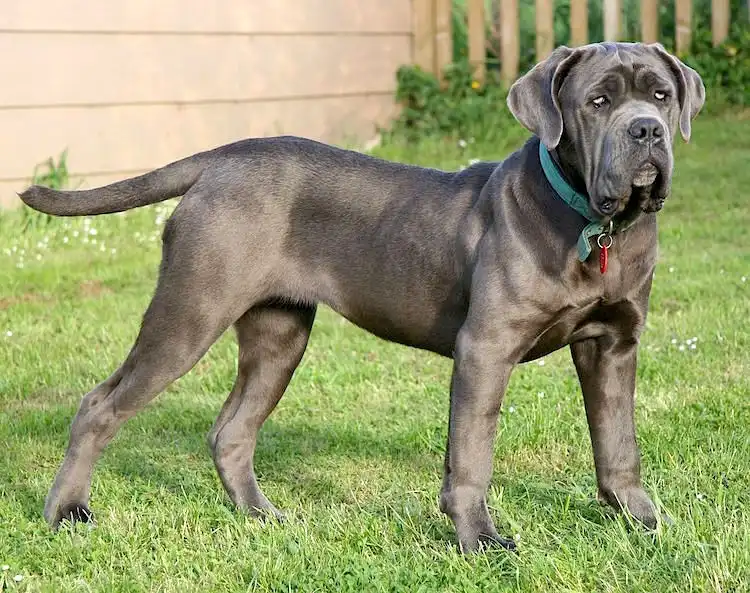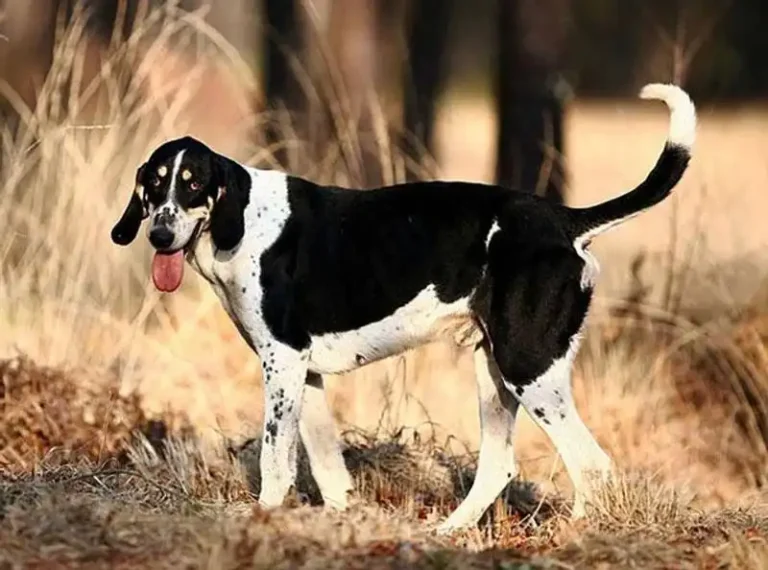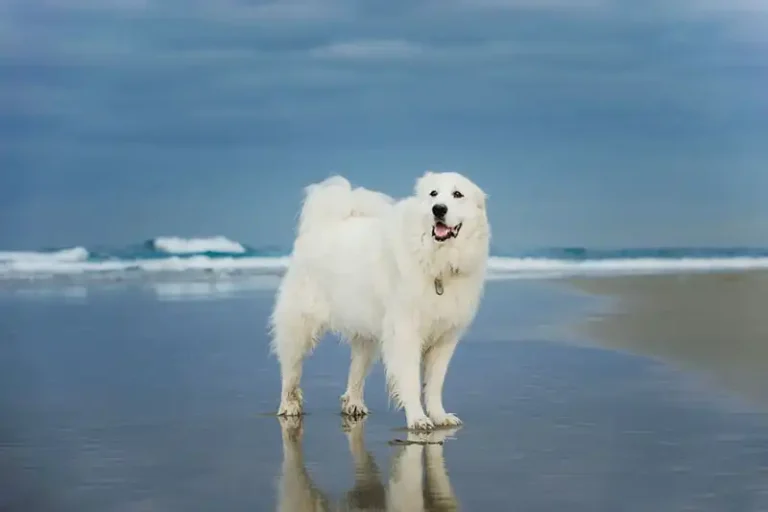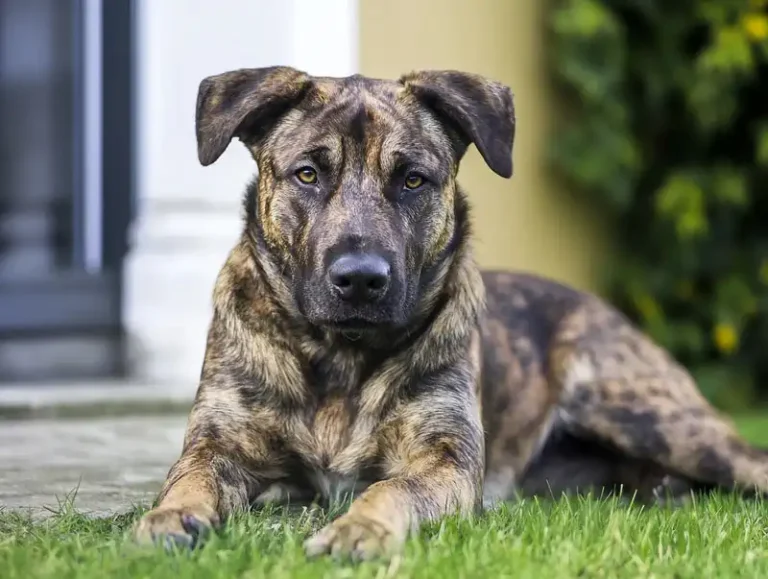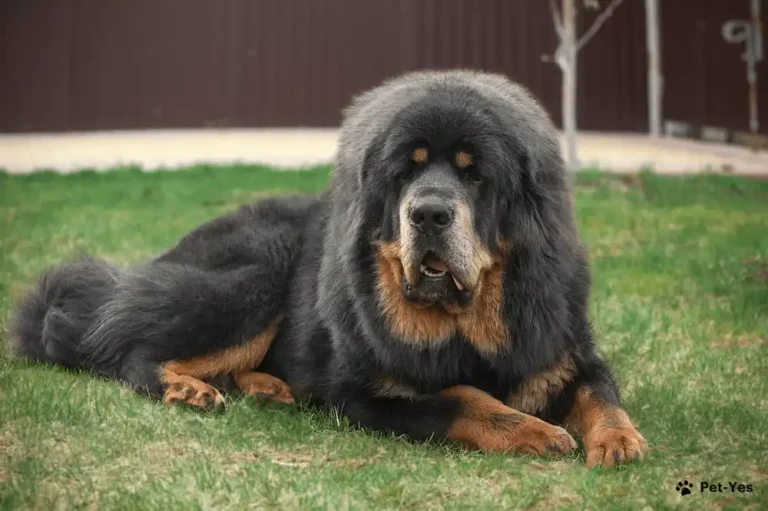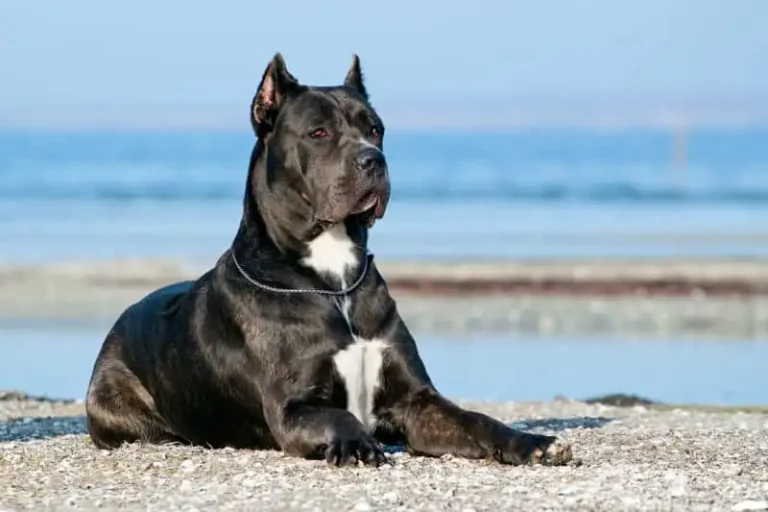Dogo Argentino – Dog Breed Information
The Argentine Dogo is a large, snow-white dog. It is distinguished by its courage and endurance. It is very devoted to its owner.
- Country of origin: ArgentinaSize: large
- Height: 60-68 cm
- Weight: 40-45 kg
- Age: 10-15 years
- FCI breed group: Pinscher and Schnauzer, Molossoid breeds, Mountain dogs and Swiss Cattle Dogs



Key Facts About Dogo Argentinos
- These dogs are the only breed bred in Argentina. The country’s residents consider it their national treasure. Another name is Dogo Argentino and Argentine Mastiff.
- In their homeland, in a country with a hot climate, such dogs most often live on the street and guard houses.
- The breed is versatile: it is mainly used for hunting large game, as family dogs or guard dogs.
- The Argentine Dogo’s coat has an interesting feature: it can “adapt” to the climatic conditions of the country in which the dog lives. If the climate is hot, it will be thinner, if cold, it will be thick and with undercoat.
- Dogo Argentino is banned in a number of countries, such as Australia, New Zealand and Portugal.
- It is believed that the character of such a dog is fully formed by about three years of age.
- In Argentina, Dogos are often used as guide dogs for the blind because they are very good at tracking.
- In hot weather, the Dogo Argentino should not be left in the blazing sun for long periods of time. It can get sunstroke.
Historical background
The Argentine Dogo owes its origin to the brothers Antonio and Agustin Martinez. They were the ones who bred these dogs in the early 19th century in the province of Cordoba, located in the central part of the Argentine Republic.
The brothers based their breed on a local fighting breed with a long history. Here it was called “Perro de petea”. They began to cross it with boxers , German and Bordeaux dogs, bull terriers , and Pyrenean mountain dogs .
Initially, they tried to use the obtained specimens as fighting dogs. But the Martinezes were not interested in dog competitions; they wanted to breed a breed that could be taken with them on a hunt for large wild animals. In particular, for pumas and peccaries (Argentine pigs that weighed up to 50 kg).
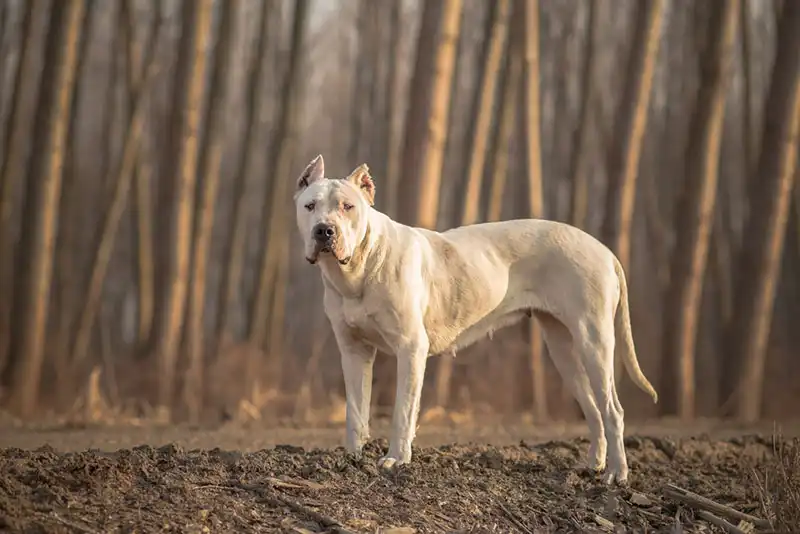
It was important for the brothers to breed a snow-white specimen, since such a dog would stand out against the background of the local nature. They wanted the dog to have excellent physical characteristics, allowing it to move quickly through the mountainous terrain.
The Martinezes continued to work on the breed for 30 long years. They developed the first standard back in 1929. It described the ideal appearance of such a dog and the characteristics of its temperament.
The death of one of the brothers, Antonio, led to the fact that the phenotype and genotype formed by many years of work were greatly changed. Numerous breeders began their work, uncontrollably crossing the resulting individuals with other dogs.
Agustin Martinez managed to restore the previous breed characteristics of the Great Danes. In addition, he worked in the Ministry of Foreign Affairs of Argentina and at every opportunity tried to give puppies to representatives of other countries. This approach contributed to the fact that the breed gradually began to gain popularity among residents of the whole world.
In May 1964, the Argentine Dogo was recognized by the Cynological Federation of Argentina. The first stud book was created that same year.
The International Cynological Federation accepted the Dogo Argentino much later – only in 1973.
The first representatives of the breed appeared in our country in 1992.
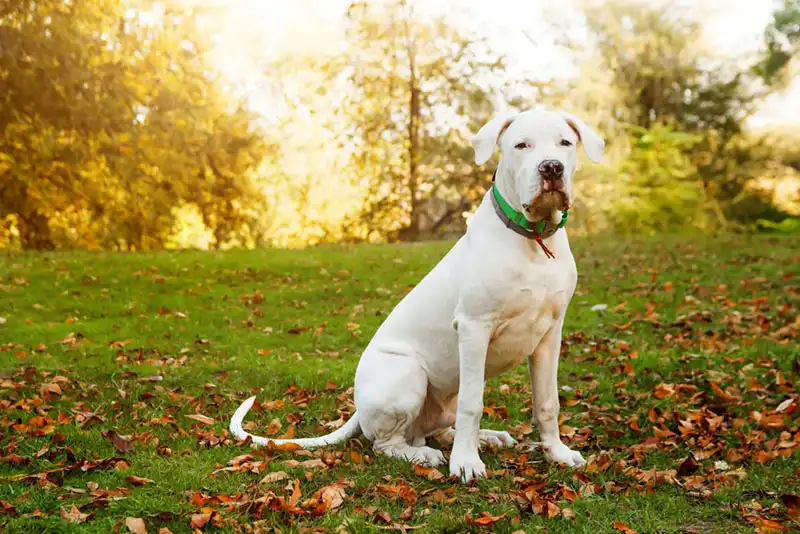
Description of the Argentine Dogo
The Argentine Mastiff is proportionally built. The animal’s well-developed muscles are visible even through the skin.
The dog must have a normal mastiff type. According to the standard, only white is allowed. The coat is short and smooth.
It is preferable for the Dogo Argentino to be tall and large. This applies to both males and females. However, a tendency to gigantism is a significant fault.
Head
The Argentine Dogo has a large size. Powerful and strong. Sharp lines of the skull are unacceptable.
The cranium appears convex. The temporal muscles are well developed.
The nostrils are wide. The nose is pigmented. Its color is black. When looking at the dog in profile, the nose appears slightly upturned.
The lips are moderately thick and black pigmented. They are dry and tightly fitting.
The jaws of the Argentine Dogo are strong and powerful. Overshot and undershot bites are not welcome. According to the standard, a straight or scissor bite is allowed.
Eyes
Should have a hazel or dark colored iris. Preferably, the eyelids should be colored black. Although a complete lack of pigment is not considered a significant fault.
The shape of the eyes of the Argentine Dogo is almond-shaped. The set is wide. The dog’s gaze is lively and interested. It looks boldly and decisively, especially in males.
Ears
The Argentine Dogo has high-set ears. The hair on them is short and smooth. The hair on the ears should be slightly shorter than on the rest of the body. The presence of markings on them is allowed.
When the dog is in a calm mood, the ears may hang slightly, when he is alert, they rise halfway.
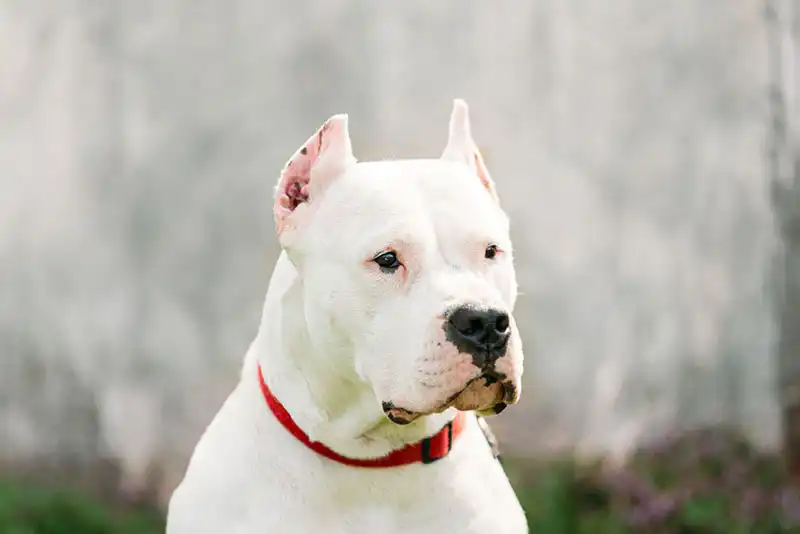
Neck
It has a medium length and a conical shape. It is set high. The nape of the neck of the Argentine Dogo looks convex. The muscles on the neck are well developed.
The skin here is thick and elastic. Folds at the throat level are always present.
Frame
The body is rectangular in shape. The back is wide and muscular. The croup of the Argentine Dogo is well developed. The chest has a special structure and impressive width, providing the dog with maximum breathing capabilities.
The ribs of the Dogo Argentino are moderately sprung. The underline should not be too curved, as in greyhounds.
Tail
In such dogs it is sabre-shaped. It is high-slung. Together with the back, it should form an angle of 45 degrees. When moving, the Argentine Dogo, according to the standard, carries its tail either at the level of the body or slightly higher than it.
Limbs
The animal’s legs are in complete harmony with its body. The front limbs appear straight and vertical from all sides.
The shoulders are well developed. The muscles on them are prominent and clearly visible. The elbows are strong, the skin on them is thick, but without folds. The paws of the front limbs of the Argentine Dogo look round. The toes on them are short, gathered into a lump. The pads are large, covered with rough skin.
The hindquarters are powerful and strong. Dewclaws are undesirable. The thighs are large. The feet of the hindquarters are similar in shape to the front ones, although they appear slightly smaller and wider.
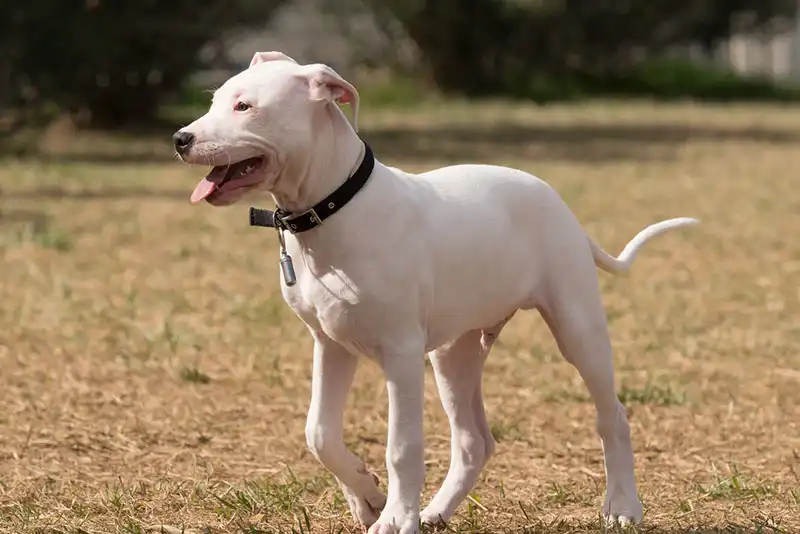
Gait
The Argentine Dogo moves confidently and quickly. If the dog shows a strong interest in something, its posture changes: it becomes tense, its head noticeably rises upward. This breed reacts very sharply to any irritant.
When walking or running, the Dogo Argentino moves its front legs forward strongly, while its back legs provide it with a good push. When the dog starts to gallop, its movements become extremely powerful.
All four feet must leave parallel tracks on the ground. Any form of pacing is a serious fault.
Wool cover
The average length of the Argentine Dogo’s coat is 1.5 to 2 cm. The coat looks uniform and smooth. Its thickness directly depends on the climatic features of the area where the pet lives.
Color
According to the standard, the coat color of Argentine Dogos is only white. The presence of black or dark marks is allowed on the muzzle – around the eye. In any case, the spot cannot cover more than 10% of the dog’s head.
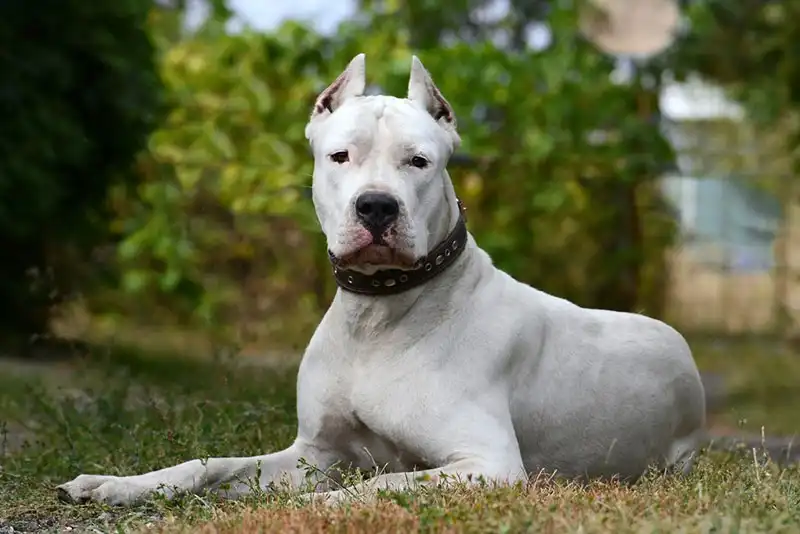
Size and weight
The ideal height for the Argentine Dogo is considered to be: 62-68 cm for males, 60-65 for females.
The average weight of an adult usually ranges from 40 to 45 kg.
Argentine Dogo Character
Since the Argentine Dogo was used as a fighting dog in ancient times, legends and myths about its ferocity and cruelty have spread throughout the world. In fact, this is not true at all.
Argentine Dogos are not used as fighters or hunters these days, they are now increasingly kept as family dogs. After all, they are very devoted to their owner and the entire family they live with. They love to be petted and hugged. Tactile contact with a person is extremely important to them.
A properly trained dog is affectionate and calm. He will never attack a stranger unless he senses a real threat. After all, the guard instinct of Argentine Dogos is very well developed. He is ready to protect all members of his family to the last.
The dog is tolerant of children. He will happily join in any active game.
Although it is not recommended to leave such a large animal unattended with children.
It is important to explain to the child how to behave correctly with a dog: you cannot hit it on purpose, pull its tail, wake it up while it is sleeping, or try to take its food bowl away from it.
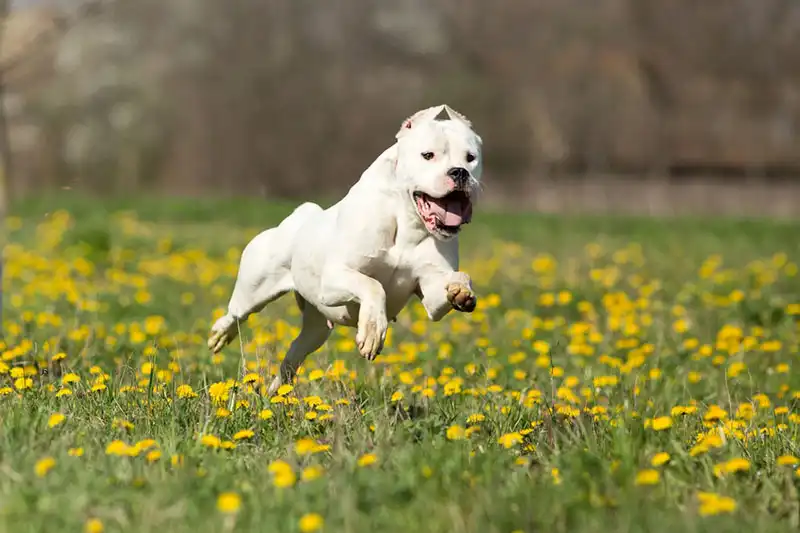
Since Argentine Dogos tend to be dominant, it is not advisable to have other pets in the same house with them. The dog will regard any small creature as prey and will chase it. Dogo Argentinos are also unlikely to get along with other dogs, especially if it is a pet of the same sex. They should not be left unattended for long periods of time in walking areas, as the likelihood of conflicts with their relatives is quite high.
Early socialization is essential for Dogo Argentinos, otherwise they will become hostile and aggressive towards other dogs and people.
They are very active and mobile. They will happily accompany their owner during jogging and cycling. They love various outings into nature. They are hardy, so they can travel with their owner through mountainous and wooded areas.
Argentine Dogos are playful. Most of them remain active and mobile until old age. Physical exercise is extremely important for them. A dog that does not splash out its accumulated energy may start to smash an apartment or house.
Argentine Dogos do not bark very often. They mainly bark when they try to warn their owner of danger. They are especially vigilant at night.
Mental stimulation is also necessary for the dog. Various intellectual games are played with the Great Dane. For example, finding a hidden object, food puzzles, etc.
The hunting instinct of the Argentine Dogo can provoke an increased interest in various new smells during a walk. That is why it is advisable to walk with him in fenced areas. In public places, the dog is muzzled and leashed.
Upbringing
Training an Argentine Dogo is a process that requires certain knowledge and skills. It is not recommended for people who do not have experience in communicating with dogs to get the breed. In addition, these dogs differ significantly from other molossers, since they were originally bred not so much to protect people as to hunt large animals.
This is why the owner of an Argentine Dogo must be able to recognize his pet’s hunting instincts and be able to control them.
The training of the dog depends entirely on the capacity in which it will be used. If the dog will perform the role of a guard, it is recommended to separate it from strangers. This will help to cultivate mistrust of strangers in it.
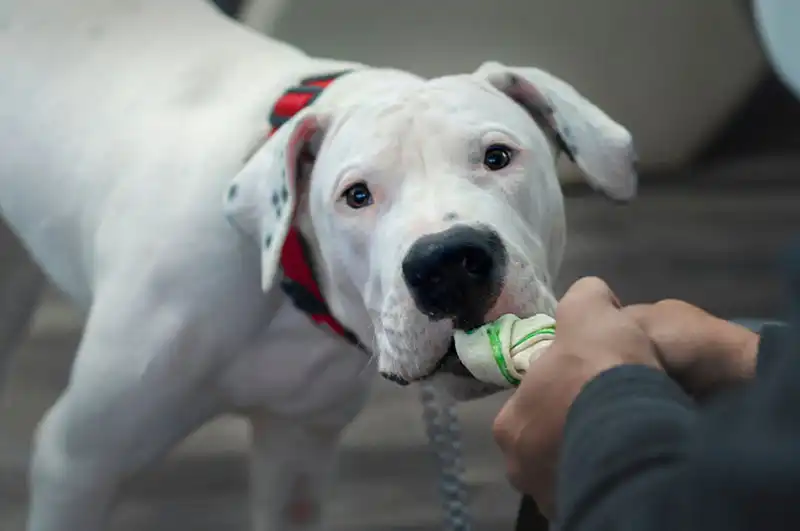
If the animal is going to be a defender, then the training is based on a different principle. Dogs have a highly developed “atavistic instinct” – the ability to find vital points on the prey. As is known, the jaw of the Argentine Dogo is very powerful, and the grip is iron. The dog will not let go of the animal until it feels that it is still alive. This ability is indispensable during the hunt, but for a guard it is not quite appropriate. The dog needs to be taught to grab the enemy by the limbs, and not by the neck, for example.
Most often, to teach a dog such skills and abilities, they turn to dog trainers. Only specialists can build the training process correctly and consistently.
Argentine Dogos have a high level of intelligence. That is why they are able to learn new information quite quickly. But the natural tendency to leadership often significantly complicates the entire process of training a dog. After all, the dog begins to dominate early – even in puppyhood. That is why the training process should begin from the first days of the pet’s appearance in the house.
During training, it is not recommended to shout at the Great Dane, and especially not to hit him.
Despite the apparent power, the animals are very emotional and sensitive. The dog can be offended and refuse to carry out any orders. Only a calm, balanced owner with a strong character can become an authority for the Great Dane.
Don’t forget about rewards. They can be tactile (stroking), verbal (praise), and “tasty”. It is best to give dry industrial food as a treat. It is very convenient to use and useful for the animal. It is not recommended to use sausages, cookies, salami, buns for rewards. This food is harmful for pets.
Training is a regular process. It is advisable to train your dog daily. This approach will allow you to teach him new commands faster and reinforce the ones he has already mastered. It is wrong to think that as soon as the dog has learned the entire set of commands, training can be stopped. Training continues throughout the pet’s life. To ensure that the dog does not forget what he has learned, training should be ongoing.
Maintenance and care
Despite their impressive size, Argentine Dogos feel great in a city apartment. In addition, due to their very short fur, such a dog cannot live in an aviary, especially in the cold season. In addition, constant contact with a person is extremely important for them. Being alone for a long time, without communication, the dog will begin to get bored.
The short coat of the Argentine Mastiff requires minimal care . For such dogs, wiping with a silicone glove brush will be enough. Shedding is average. Regular combing not only removes dead hair, but also gives the pet a massage, which improves blood supply to the skin.
In the autumn-spring period, when there is a lot of dirt outside, you will have to wash this snow-white dog after each walk. But the dog is not bathed completely. Only the limbs and belly need to be washed with warm water. In winter, the paws are washed with water and soap, since the roads in the cities are sprinkled with special anti-icing reagents – sand and salt sets. Such substances can cause irritation on the paws of the Great Dane.
To protect against salt in winter, you can use waxes.
These products help reduce the effects of cold temperatures on your dog’s skin and prevent cracks and scratches.
It is not advisable to bathe the animal too often. Once a month will be enough. For this procedure, special dog shampoos are purchased, the best option is for dogs of light colors. After washing, the dog is thoroughly wiped with a towel.
The animal’s eyes also require care. They need to be cleaned from the mucus accumulated in the corners as needed.
Dogs living in the city and often walking on asphalt usually do not need to have their claws trimmed. They wear them down on the road themselves. Other dogs have their claws trimmed using claw cutters. Claws are trimmed about once every 2 weeks.
For the first procedure, it is recommended to visit a groomer. A professional will demonstrate visually how to properly perform such a procedure: show which part of the overgrown claw should be removed and which should be left. This is very important, since there are nerve endings and blood vessels inside it.
Ears are usually cleaned 1-2 times a week. It is recommended to use veterinary lotions for this purpose. It is not advisable to use baby powders and creams, peroxide, boric alcohol.
It is permissible to brush the animal’s teeth every day. This will help to avoid the appearance of plaque on the enamel, tartar and caries. For cleaning, buy dog toothpastes and special brushes.
The pet is accustomed to any hygienic procedures from a very early age. After each successful grooming attempt, it is important to use rewards. This will help form a positive attitude towards such procedures in the dog. Do not yell at the dog if it is naughty and does not want to come to you. You need to try to find an individual approach to the animal, to interest it.
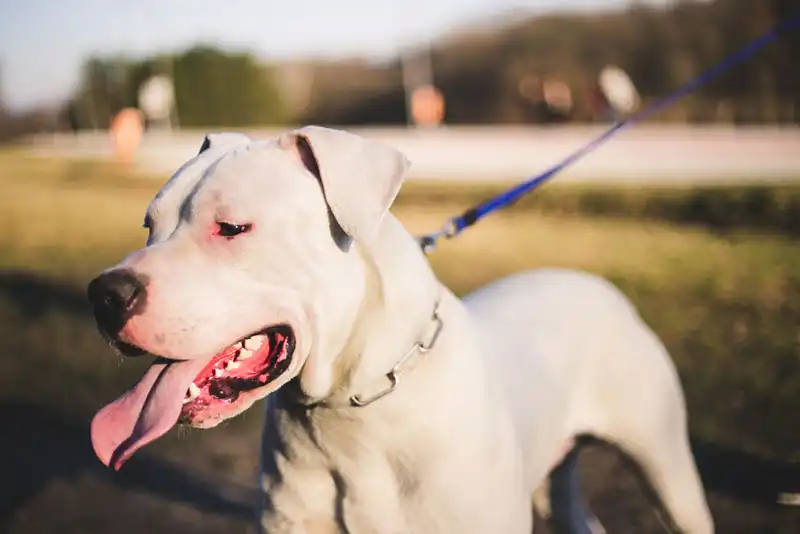
Argentine Dogo Nutrition
By human standards, a dog’s life is quite short. On average, Argentine Dogos live 10-15 years. Every owner should understand that the life expectancy of a pet is influenced by several factors: proper maintenance and balanced nutrition.
It is not recommended to feed the animal with scraps from the human table. You need to cook for it separately. The diet of a pet should be dominated by protein, since the dog is a zoophage, that is, a carnivore.
Carbohydrates are also present in the diet, but there are much fewer of them. The animal’s digestive system absorbs them much worse than proteins.
- The intake of microelements, vitamins and healthy fats into the body is important.
- When choosing a feeding plan for your dog, there are several factors to consider:
- Her breed;
- Animal activity;
- Age;
- Health status.
An unbalanced diet leads to a number of negative consequences: the pet’s fur will become dull, intestinal problems may appear, etc.
To create a nutrition plan for your pet, you need to contact a specialist. A professional nutritionist will take into account all the characteristics of a specific pet and develop a diet specifically for it. It is wrong to think that you can calculate the average norm for your dog by reading the information on the packaging of ready-made food or by studying literature on nutrition.
There are two types of nutrition: natural products and industrial rations , which are dry and wet. The latter are also divided into complete and incomplete. Their main difference is in the composition: the former are supplemented with vitamins and microelements, the latter are not.
When choosing one of the feeding types for a dog, the owner must take into account the characteristics of each of them.
So, with a natural diet, he will have to buy a large number of different products and cook them himself, calculate the calorie content of each portion. If a person does not have time for frequent shopping, it is better to use ready-made rations. This food can be bought in advance, since its shelf life is much longer. In addition, it is easier to store: for dry food, for example, you do not even need a refrigerator.
It is important to follow the regime. It is recommended to feed the animal at certain times. After it has eaten, the bowl should be removed until the next meal. Only a container with drinking water is left.
Every owner should understand that there are a number of products that are not only harmful to a dog, but also dangerous. For example, chocolate, bones, raw fish and pork. Sweets and smoked foods should also not be given to the animal.
For example, eating tubular bones can lead to extremely undesirable consequences: their chips sometimes damage the intestinal walls, breaking through them. Often, this condition leads to the death of the pet.
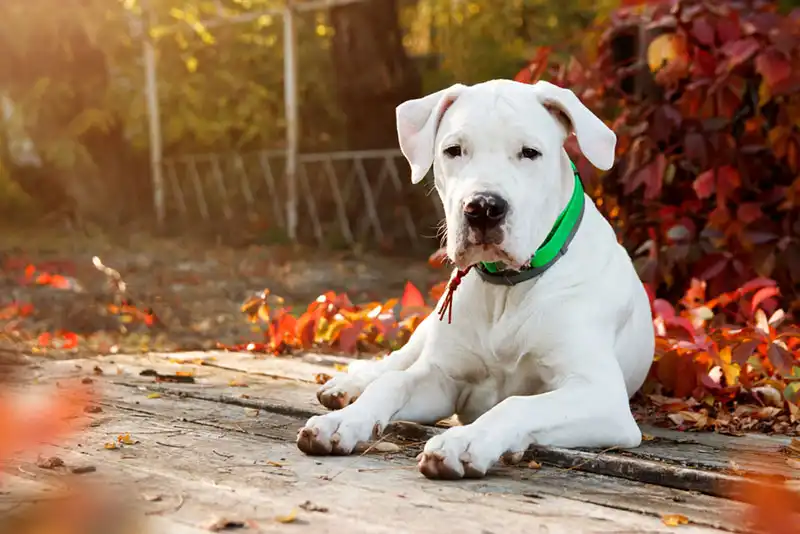
Predisposition to diseases
The breed is predisposed to certain types of diseases. For example, some individuals are born deaf. It is believed that this is a consequence of their snow-white color. Some of them are deaf in only one ear, and some are deaf in both.
Allergic reactions are often diagnosed in Argentine Dogos. If you notice any rashes on the skin, immediately contact a specialist and eliminate all potential allergens from the diet.
Animals that lead an active lifestyle need to be closely monitored: they often suffer from injuries, dislocations and sprains.
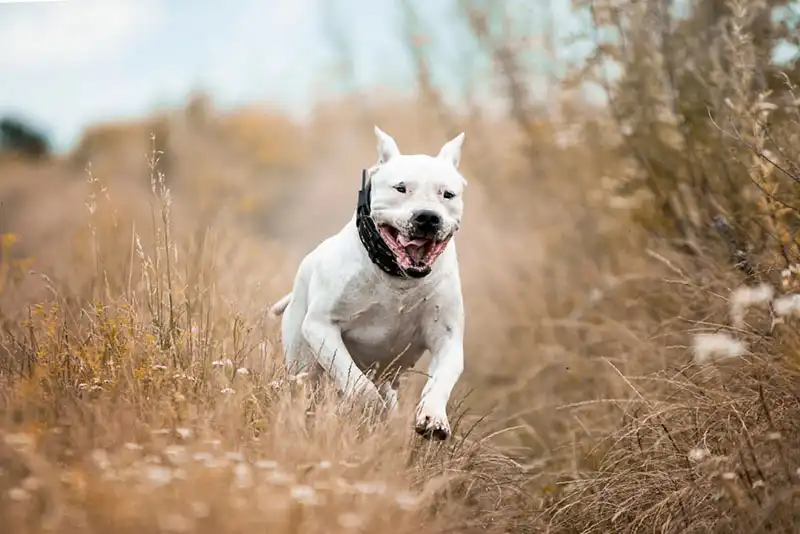
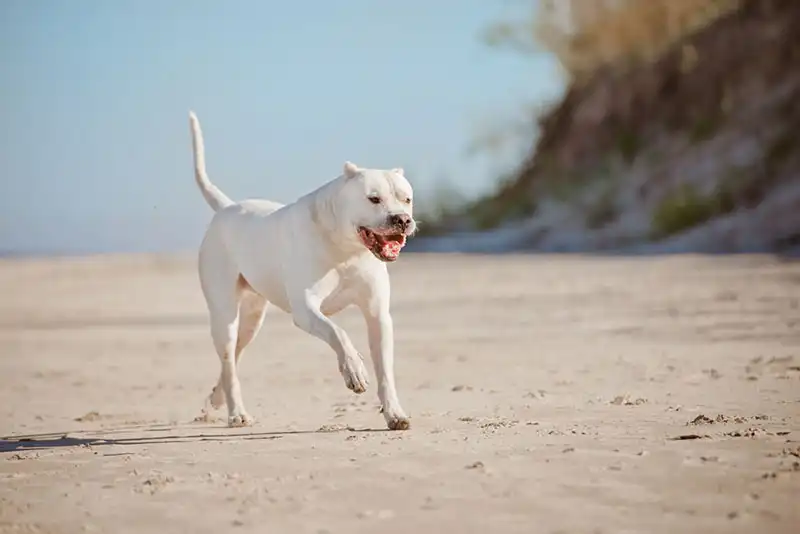

Who are Argentine Dogos suitable for?
- The Argentine Mastiff is suitable for dog owners who plan to get a dog:
- Large, strong and hardy;
- Suitable for the role of a security guard, protector;
- With short, snow-white fur that does not require frequent grooming;
- Affectionate with his family.
- Don’t have time to walk the animal regularly;
- Not ready for frequent physical activity and training;
- Never had a dog before;
They don’t want a pet that is prone to dominance.
A large pet needs a confident and active owner who can become an authority for him. Physical exercise is extremely important for such an athletic dog.
It is not advisable for families that already have cats or other animals to get a Great Dane. Often dogs, obeying their hunting instinct, chase other pets, perceiving them as prey.
Great Danes can be purchased by both single and family dog owners. The most important thing is to devote enough time to the pet: walk it regularly, train it and educate it.
Tips for choosing a puppy
Before choosing a breed, you need to learn as much about it as possible. You can’t choose the Argentine Dogo if you just liked its exterior.
Before buying, talk to dog breeders, breeders, cynologists. Try to learn more about the breed, its temperament, maintenance features, etc.
It is advisable to buy a puppy that has reached the age of 1.5-2 months. It is this dog that can already be weaned from its mother.
Dogs are bought either from private breeders or from specialized nurseries. It is believed that the probability of acquiring a highly-bred individual in a nursery is much higher. In any case, the breeder must be chosen very carefully.
When visiting the room where the puppies and their mother are kept, pay attention to its condition: it cannot be dirty. The dogs should also look neat.
Examine the baby itself: the condition of its fur, eyes, ears. Its belly should be soft, not tight. A bloated belly is most often a sign of parasite infestation .
Ask the breeder to show you the puppy’s parents. This will give you a clearer idea of what your pet might grow up to be.
By the age of one and a half months, the dog already has teeth in its mouth. Be sure to check for them. The bite should be correct. In Argentine Dogos, it is acceptable to have either a straight or scissor bite.
Ask the seller whether the baby has received all the necessary vaccinations and whether it has been treated against parasites.
Pay attention to the behavior of the litter. They should not hide from guests. On the contrary: healthy puppies will always show interest in everything new. They will come up to you and start sniffing you. The kids are playful and active, they rarely sit in one place.
Breeders who carefully monitor their Argentine Mastiff puppies will give them a BAER test. This test helps determine whether they are born deaf. This is important for Dogo Argentinos, as they are often born deaf in one or both ears.
In professional nurseries, the buyer is always provided with documents for the dog: a veterinary passport, a birth certificate. The majority of such organizations put a brand on their charges – a unique code assigned to each animal. It helps to identify the pet when necessary. The code must be included in the documentation.
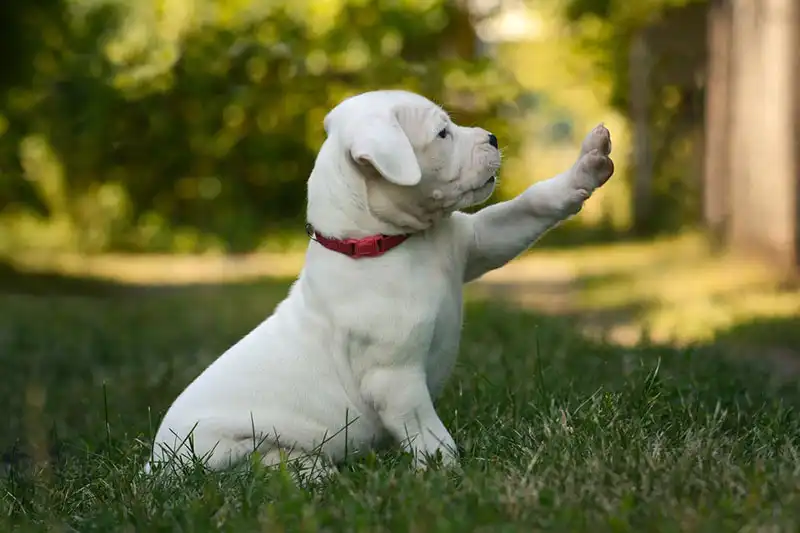
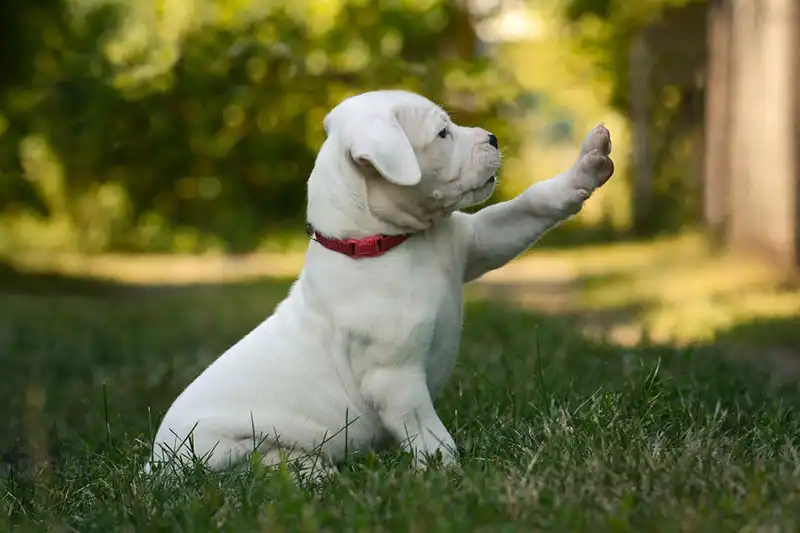
Owners’ opinion
- Having studied the impressions of dog owners about this breed, we came to the conclusion that they consider such pets:
- Smart and resourceful;
- Real athletes, distinguished by strength and endurance;
- Physically active;
- Affectionate and devoted.
Owners note that Argentine Dogos are not very popular in our country. In addition, it is not so easy to find an experienced breeder. You should not contact the first person you meet, you need to choose carefully. Otherwise, there is a high chance of acquiring a dog with a set of genetic abnormalities.
Since Argentine Dogos are often prone to stubbornness, dog breeders recommend contacting specialists for quality education and training.
The pet needs a lot of walks. It needs active games in nature. You can take Argentine Dogos for a walk outside the city. Favorite games are stippling poles (a competition for hanging on a rope), playing with a stick, exercises with a tire, etc.
The protective instinct of such an animal is very well developed. The dog will always warn the owner of danger with a loud bark. In normal circumstances, Argentine Dogos bark quite rarely.
Price of Argentine Dogo
In our country, you can find not so many breeding nurseries engaged in breeding Dogo Argentino. Therefore, the breed is considered quite rare. You need to be prepared for the fact that the cost of a puppy will be quite high.
We talked to some breeders and found out how much Argentine Dogos cost.
In specialized nurseries the price is always higher – from 50 to 70 thousand rubles. Private breeders usually sell their dogs cheaper. Their price is from 15 to 40 thousand.

